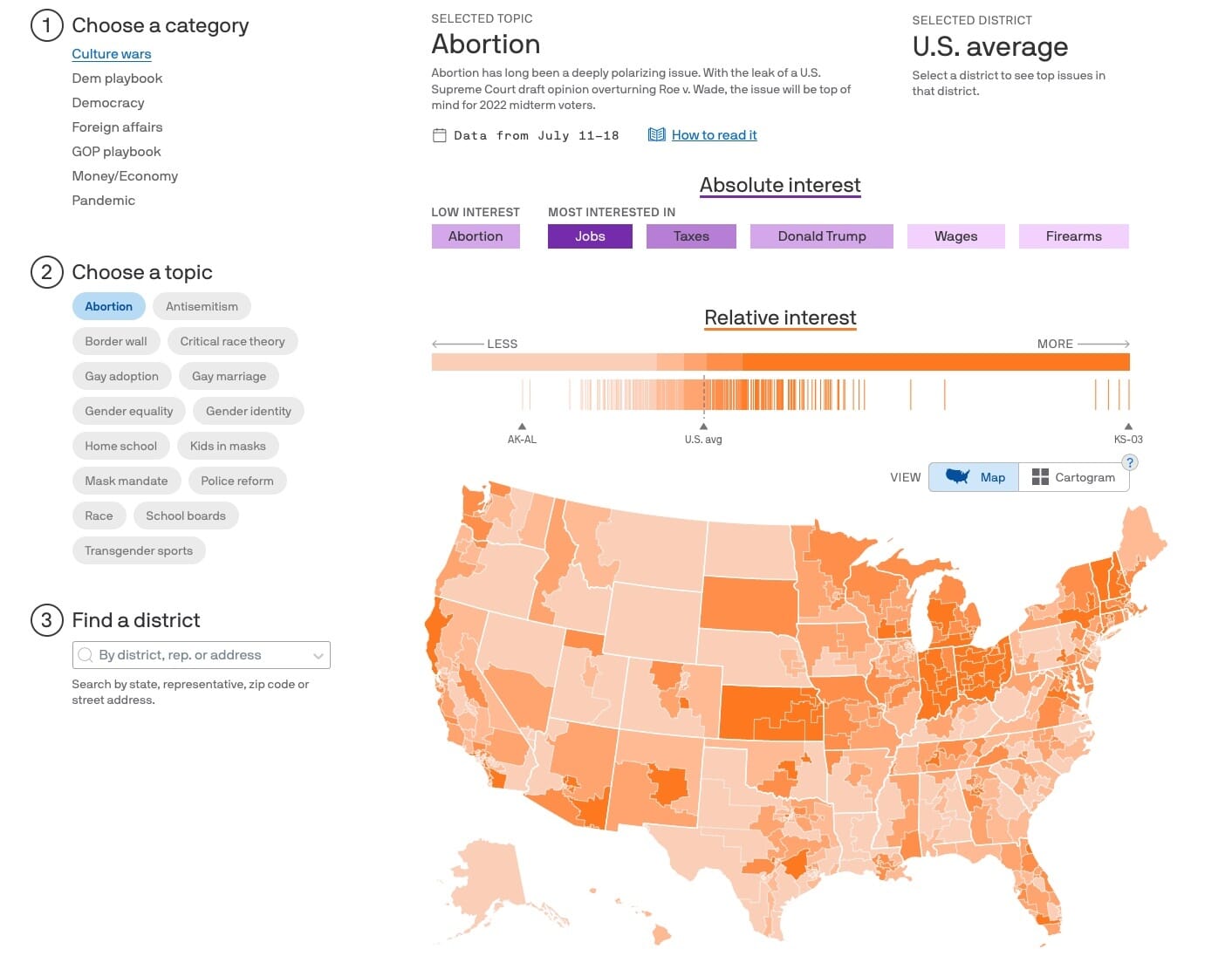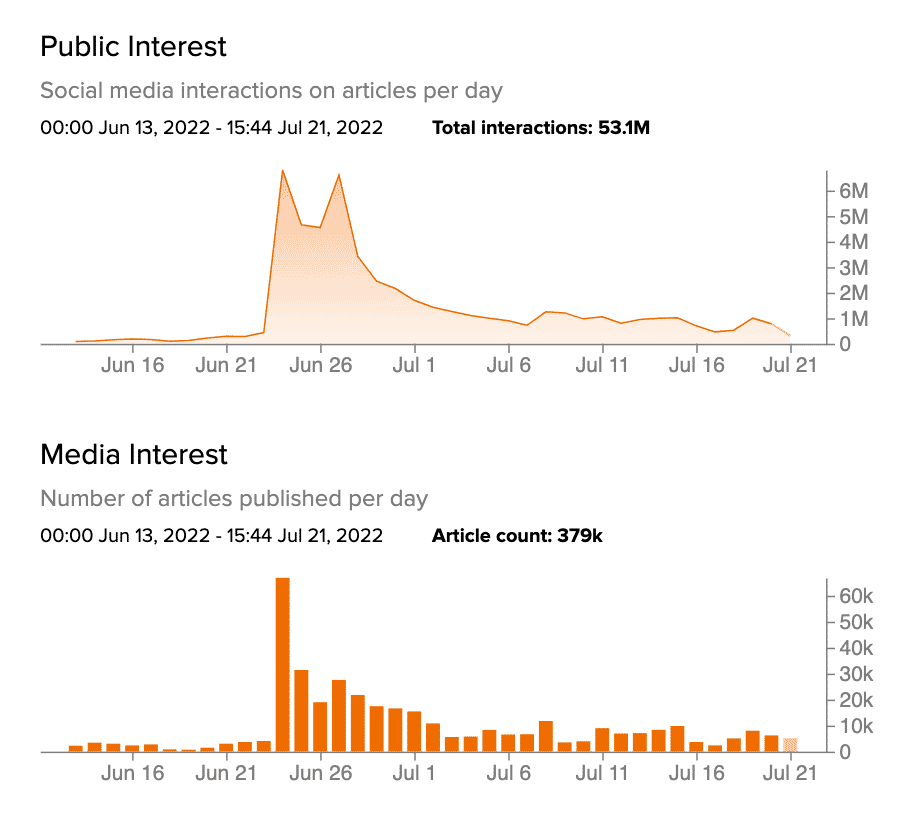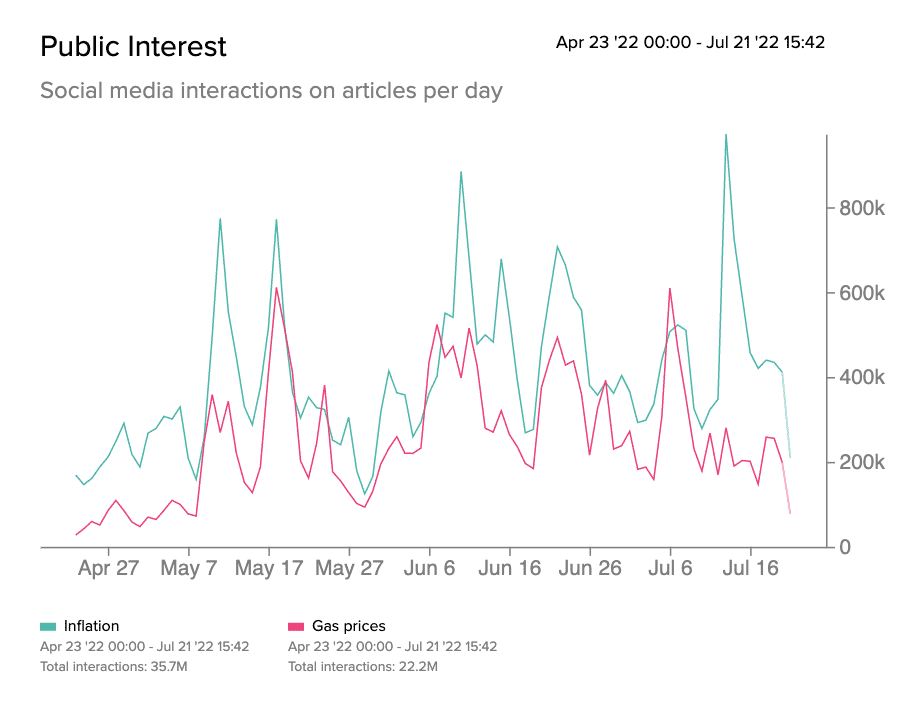With the U.S. midterm elections around the corner on November 8, Americans have a lot of different election issues on their minds. What might those topics be and how do they wax and wane in importance over an election cycle? Using data from various sources, news website Axios is trying to find more about the issues Americans are thinking about and how interest in various topics changes over time.
Since its founding, data has played a key role in the way Axios tells stories. Its reporters have used NewsWhip data to see how certain topics, such as the war in Ukraine and the Uvalde mass shooting, have trended over time, and it’s now built a Google Trends-powered dashboard to get more insight into the election issues Americans are talking about.
In May, visual journalists Jacque Schrag and Will Chase, along with politics reporter Stef Kight, created Axios’ midterm election issues dashboard to track interest in a number of key topics. The dashboard examines data at a national level by ranking the most searched topics on Google, then locally, within each congressional district. It then ranks each district’s interest in a topic relative to other districts.

While data, whether it comes from NewsWhip or Google, isn’t meant to predict election outcomes, it does give readers insight into the topics and issues people care about most at any given time. “One of the main reasons we built this particular kind of map is because we really do believe that politics is local,” explains Kight. “What voters care about will change district to district.”
If there’s anything the Axios team has learned from the data, it’s that hot topics can come and go, while some issues, in particular jobs and taxes, will always rank high. Indeed, what’s been most interesting to watch, says Schrag, is how slots three through 10 have shifted over time and across congressional districts. Here are three issues that voters have been paying careful attention to over the last month and how interest in these topics has evolved.
Abortion interest wanes
While abortion has been a controversial topic for many over the last decade, it’s remained relatively low on people’s list of interests. That changed on June 24, when the Supreme Court overturned Roe v. Wade, giving states the power to make their own abortion laws. On that day NewsWhip’s data recorded more than six million interactions and 60,000 news articles. Today, the volume of interactions and articles is a tenth of what it was on the day of the decision.

What’s changed? Schrag says the abortion issue, and other topics that rapidly rise to the surface, are similar to cultural events in the way they take over the national dialogue for a period of time and then lose their footing. “Seeing abortion spike from being in the bottom of the top 20 all the way up to number two after the decision on Roe came down – that was a very big jump that has not been seen with any other terms,” she says. Currently, the Google Trends dashboard shows that abortion is a “low interest” topic, with people caring more about it in certain districts in Kansas, Florida, Minnesota and Ohio, and less so in areas in West Virginia, Pennsylvania, California and Nevada.
Firearms stays steady
One topic that continually rises and falls in importance is firearms. Axios and NewsWhip often see interest in gun control increase after a mass shooting and then drop back to more normal levels as time goes on. Given how big of an issue gun control has been for so long, you might think that it would be a perennial trending topic, but an Axios article, which used NewsWhip data and was written after the Uvalde shooting in May, found that Americans have had a limited attention span when it comes to guns.
That said, Axios’s Google Trends-driven dashboard has found firearms may be an issue with staying power through the midterm elections. Schrag notes that the search term has maintained a very high level of interest since the Buffalo mass shooting, which occurred 10 days before Uvalde. “Sometimes [trends sustain] because of other tragic events that happened afterwards and other times it’s due to movement on legislation and policy changes,” she explains.
Inflation and gas rise and fall together
One of the most interesting data trends tracked by both NewsWhip and Axios’s dashboard is the correlation between interest in inflation and gas prices. As pump costs have increased and decreased over the last three to four months, social media interactions and Google searches have surged up and down – not just on the topic of fuel, but about inflation as well. “We’ve seen interest in gas prices and inflation kind of coincide,” notes Kight.
NewsWhip data tells much the same story, as shown in the chart below.

Currently, Axios’s dashboard lists inflation as a medium interest topic, and gas prices – which have started to come down – as a low interest topic. However, Schrag notes that it’s possible inflation is a bigger concern than it appears. Because the dashboard is driven by Google Trends, if people are searching for other phrases like “Why is the cost of milk so high?” then that term wouldn’t be reflected in the inflation-specific data, she says.
Like all data, whether it comes from social media interactions, news articles or search terms, context is what matters. In the case of Axios, local reporters help add context by paying attention to different search terms and asking questions to find out why people in particular districts are more interested in certain issues than others. “It’s very much meant to be a starting point, and not the be-all and end-all,” says Schrag. “We can’t tell you why people are searching, but we can put together the context.”











